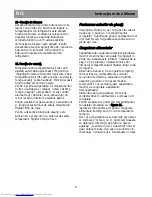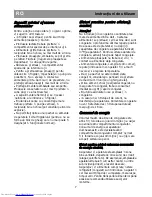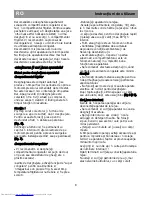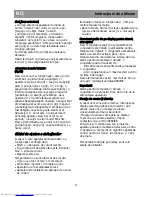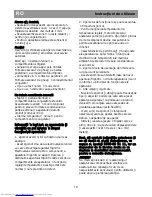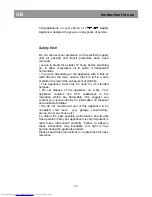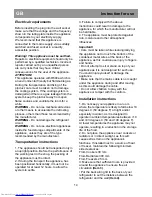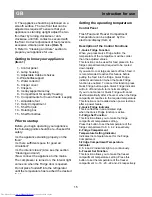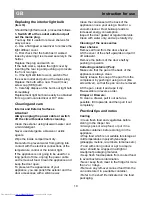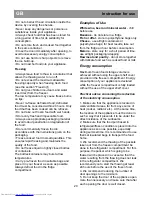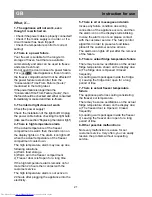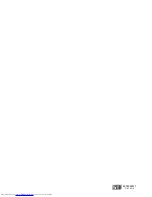
20
• Do not obstruct the air circulation inside the
device by covering the shelves.
• Never keep any dangerous or poisonous
substances inside your appliance.
• Always check food that has been stored for
a long period of time for its suitability for
consumption.
• Do not store fresh and cooked food together
in the same container.
• Close the door immediately after opening, to
avoid unnecessary energy consumption.
• Do not use hard or sharp objects to remove
the ice build-up.
• Do not load hot food into your appliance.
Freezing
• Always leave food to thaw in a container that
allows the thawing water to run off.
• Do not exceed the maximum allowable
freezing capacity when freezing fresh food
(see the section "Freezing")
• Do not give children ice-cream and water
ices direct from the freezer.
The low temperature may cause freeze burns
on lips.
• Never re-freeze defrosted food; defrosted
food must be consumed within 24 hours. Only
food that has been cooked can be refrozen.
• Do not take out frozen food with wet hands.
• Store only fresh and impeccable food.
• Always use appropriate packaging material
to avoid odour penetration or degradation of
the food.
• Store commercially frozen food in
accordance with the instructions given on the
packaging.
• Freeze cooked food in small quantities. This
ensures rapid freezing and maintains the
quality of the food.
• Do not freeze liquid in tightly closed bottles
or containers.
The bottles/containers may burst at low
temperatures.
• Carry pre-frozen food in suitable bags and
place it in your freezer as soon as possible.
Always defrost food in the fridge
compartment.
Examples of Use
White wine, beer and mineral water
- chill
before use
Bananas
- do not store in a fridge
Fish or offal
- store in polyethylene bags only
Cheese
- use airtight containers or
polyethylene bags; for best results, take out
from the fridge an hour before consumption.
Melons
- store only for a short period of time,
use airtight packaging/wrapping
Raw meat and poultry
- do not store together
with delicate food such as cooked food or milk.
Energy consumption
Maximum frozen food storage volume is
achieved without using the upper shelf cover
provided in the freezer compartment. Energy
consumption of your appliance is declared
while the freezer compartment is fully loaded
without the use of the upper shelf
cover.
Practical advice concerning the reduction
of the electricity consumption
1. Make sure that the appliance is located in
well-ventilated areas, far from any source of
heat (cooker, radiator etc.). At the same time,
the location of the appliance must be done in
such a way that it prevents it to be under the
direct incidence of the sunbeams.
2. Make sure that the food purchased in
refrigerated/frozen condition is placed into the
appliance as soon as possible, especially
during summertime. It is recommended to use
thermal insulated bags to transport the food
home.
3. We recommend the thawing of the packets
taken out from the freezer compartment be
done in the refrigerator compartment. For this
purpose, the packet which is going to be
thawed will be placed in a vessel so that the
water resulting from the thawing does not leak
in the refrigerator compartment. We
recommend you to start the thawing at least
24 hours before the use of the frozen food.
4. We recommend reducing the number of
door openings to the minimum.
5. Do not keep the door of the appliance open
more than necessary and make sure that after
each opening the door is well closed.
GB
Instruction for use
Summary of Contents for DBKE386XI+
Page 1: ...DBKE386XI RO Instrucţiuni de utilizare GB Instruction for use ...
Page 2: ......
Page 6: ...2 1 ...
Page 7: ...3 5 9 4 7 6 8 10 11 ...
Page 31: ......
Page 32: ...4578332911 31 07 2012 ...

